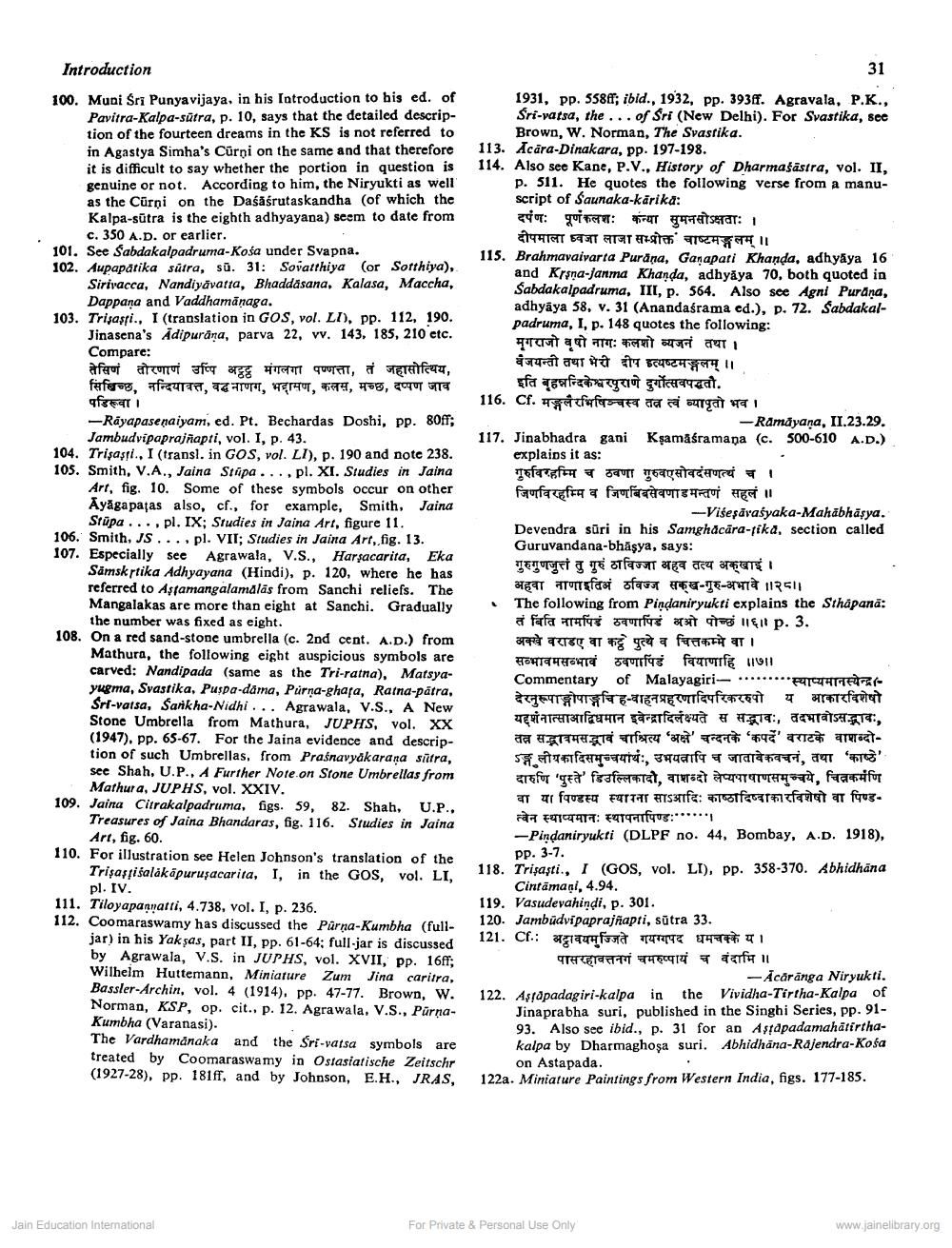________________
31
Introduction 100. Muni Sri Punyavijaya. in his Introduction to his ed. of
Pavitra-Kalpa-sutra, p. 10, says that the detailed description of the fourteen dreams in the KS is not referred to in Agastya Simha's Cūrni on the same and that therefore it is difficult to say whether the portion in question is genuine or not. According to him, the Niryukti as well as the Cürni on the Daśāśrutaskandha (of which the Kalpa-sutra is the eighth adhyayana) seem to date from c. 350 A.D. or earlier. See Sabdakalpadruma-Kosa under Svapna. Aupapatika sūtra, sū. 31: Sovatthiya (or Sotthiya), Sirivacca, Nandiyāvatta, Bhaddasana. Kalasa, Maccha,
Dappana and Vaddhamanaga. 103. Trisasti., I (translation in Gos, vol. LTD. pp. 112, 190.
Jinasena's Adipurana, parva 22, vv. 143, 185, 210 etc. Compare: तेसिणं तोरणाणं उप्पि अट्ठट्ट मंगलगा पण्णत्ता, तं जहासोत्थिय, सिखिच्छ, नन्दियावत्त, वद्ध नाणग, भद्दामण, कलस, मच्छ, दप्पण जाव पडिरूवा। -Rayapasenaiyam, ed. Pt. Bechardas Doshi, pp. 80ff;
Jambudvipaprajnapti, vol. I, p. 43. 104. Trisasti., I (transl. in Gos, vol. LI), p. 190 and note 238. 105. Smith. V.A., Jaina Stipa ..., pl.XI. Studies in Jaina
Art, fig. 10. Some of these symbols occur on other Ayagapatas also, cf., for example, Smith, Jaina
Stüpa ..., pl. IX; Studies in Jaina Art, figure 11. 106. Smith.Js.... pl. VII; Studies in Jaina Art..fig. 13. 107. Especially see Agrawala, V.S., Harsacarita, Eka
Samskrtika Adhyayana (Hindi), p. 120, where he has referred to Asramangalamalās from Sanchi reliefs. The Mangalakas are more than eight at Sanchi. Gradually
the number was fixed as eight. 108. On a red sand-stone umbrella (c. 2nd cent. A.D.) from
Mathura, the following eight auspicious symbols are carved: Nandipada (same as the Tri-ratna), Matsyayugma, Svastika, Puspa-dama, Purna-ghafa, Ratna-pätra, Sri-vatsa, Saikha-Nidhi ... Agrawala, V.S., A New Stone Umbrella from Mathura, JUPHS, vol. XX (1947). pp.65-67. For the Jaina evidence and description of such Umbrellas, from Prašnavyäkarana sitra, see Shah, U.P.,AFurther Note.on Stone Umbrellas from
Mathura, JUPHS, vol. XXIV. 109. Jaina Citrakalpadruma, figs. 59, 82. Shah, U.P..
Treasures of Jaina Bhandaras, fig. 116. Studies in Jaina
Art, fig.60. 110. For illustration see Helen Johnson's translation of the
Trisastisalākāpurusacarita, I, in the GOS, vol. LI,
pl. IV. 111. Tiloyapanmatti, 4.738, vol. I, p. 236. 112. Coomaraswamy has discussed the Purna-Kumbha (full
jar) in his Yaksas, part II, pp. 61-64; full-jar is discussed by Agrawala, V.S. in JUPHS, vol. XVII, pp. 16ff; Wilhelm Huttemann, Miniature Zum Jina caritra, Bassler-Archin, vol. 4 (1914). pp. 47-77. Brown, W. Norman, KSP, op. cit., p. 12. Agrawala, V.S., PurnaKumbha (Varanasi). The Vardhamanaka and the Sri-vatsa symbols are treated by Coomaraswamy in Ostasiatische Zeitschr (1927-28), pp. 181ff, and by Johnson, E.H., JRAS,
1931, pp. 558ff; ibld., 1932, pp. 393ff. Agravala, P.K., Sri-vatsa, the ... of Sri (New Delhi). For Svastika, see
Brown, W. Norman, The Svastika. 113. Acāra-Dinakara, pp. 197-198. 114. Also see Kane, P.V., History of Dharmaśāstra, vol. II,
p. 511. He quotes the following verse from a manuscript of Saunaka-kārika: दर्पणः पूर्णकलश: कन्या सुमनसोऽक्षताः ।
दीपमाला ध्वजा लाजा सम्प्रोक्त चाष्टमङ्गलम् ॥ 115. Brahmavaivarta Purana, Ganapati Khanda, adhyâya 16
and Krsna-janma Khanda, adhyâya 70, both quoted in Sabdakalpadruma, III, p.564. Also see Agni Purana, adhyâya 58. v. 31 (Anandaśrama ed.), p. 72. Sabdakalpadruma, I, p. 148 quotes the following: मृगराजो वृषो नागः कलशो व्यजनं तथा । वैजयन्ती तथा भेरी दीप इत्यष्टमङ्गलम् ।।
इति बृहन्नन्दिकेश्वरपुराणे दुर्गोत्सवपद्धती. 116. Cf. मङ्गलैरभिषिञ्चस्व तत्र त्वं व्यापृतो भव ।
-Ramayana, II.23.29. 117. Jinabhadra gani Ksamasramana (c. 500-610 A.D.)
explains it as: गुरुविरहम्मि च ठवणा गुरुवएसोवदंसणत्थं च ।। जिणविरहम्मि व जिणबिंबसेवणाडमन्तणं सहलं ।।
-Visesāvasyaka-Mahābhāsya. Devendra sūri in his Samghācāra-fika, section called Guruvandana-bhāsya, says: गुरुगुणजुत्तं तु गुरु ठाविज्जा अहव तत्य अक्खाई। अहवा नाणाइतिरं ठविज्ज सक्ख-गुरु-अभावे ॥२८॥ The following from Pindaniryukti explains the Sthapana: तं बिति नामपिड ठवणापिंडं अओ पोच्छं ॥६॥p.3. अक्खे वराडए वा कटू पुत्थे व चित्तकम्मे वा। सम्भावमसम्भावं ठवणापिंडं वियाणाहि ॥७॥ Commentary of Malayagiri-........"स्थाप्यमानस्येन्द्र (देरनुरूपाङ्गोपाङ्गचिह-वाहनाहरणादिपरिकररुपो य आकारविशेषो यदर्शनात्साआद्विधमान इवेन्द्रादिलक्ष्यते स सद्भावः, तदभावोऽसद्भावः. तत्र सद्भावमसद्भावं चाश्रित्य 'अक्षे' चन्दनके 'कपर्दे' बराटके वाशब्दोऽङ्ग लीयकादिसमुच्चयार्थः, उभयतापि च जातावेकवचनं, तथा 'काष्ठे' दारुणि 'पुस्ते' डिउल्लिकादो, वाशब्दो लेप्यपाषाणसमुच्चये, चित्रकर्मणि वा या पिण्डस्य स्थापना साऽआदिः काष्ठादिष्वाकारविशेषो वा पिण्डत्वेन स्थाप्यमानः स्थापनापिण्डः...." - Pindaniryukti (DLPF no. 44, Bombay, A.D. 1918),
pp.3-7. 118. Trisasti., I (Gos, vol. LI), pp. 358-370. Abhidhāna
Cintamani, 4.94. 119. Vasudevahindi, p. 301. 120. Jambudvipaprajnapti, sātra 33. 121. Cf.: अट्टावयमुज्जिते गयग्गपद धमचक्के य । पासरहावत्तनगं चमरुप्पायं च वंदामि ॥
-Acaranga Niryukti. 122. Astăpadagiri-kalpa in the Vividha-Tirtha-Kalpa ___Jinaprabha suri, published in the Singhi Series, pp.91
93. Also see ibid., p. 31 for an Astapadamahātirthakalpa by Dharmaghosa suri. Abhidhāna-Rajendra-Kosa on Astapada.
. 122a.Miniature Paintings from Western India, hgs. 177-183.
Jain Education International
For Private & Personal Use Only
www.jainelibrary.org




